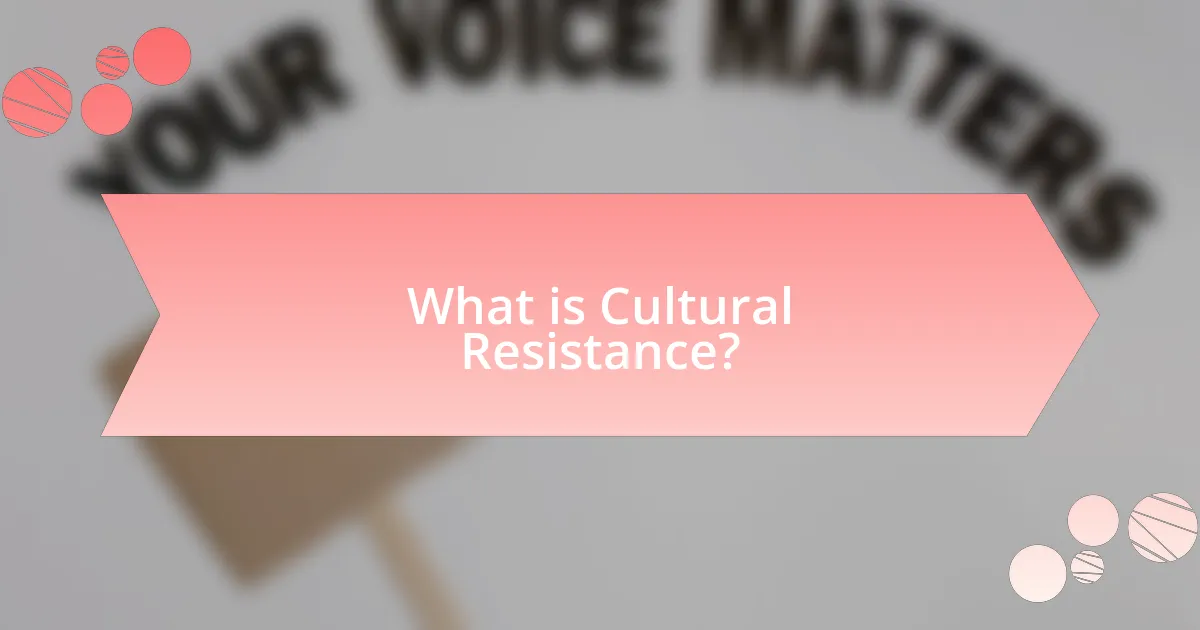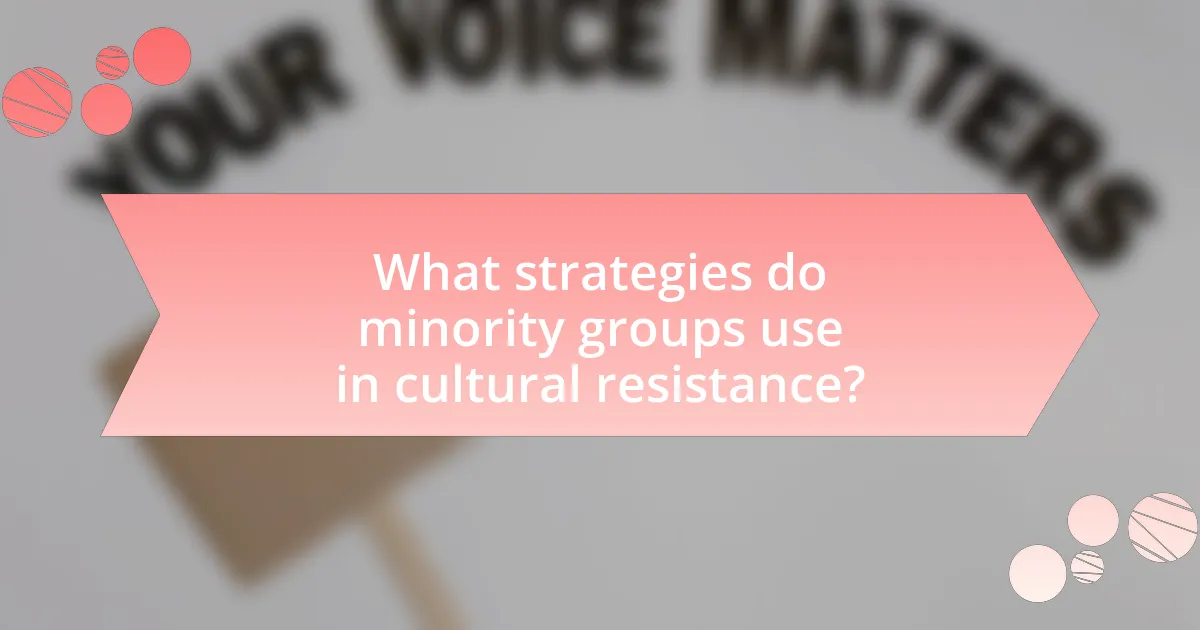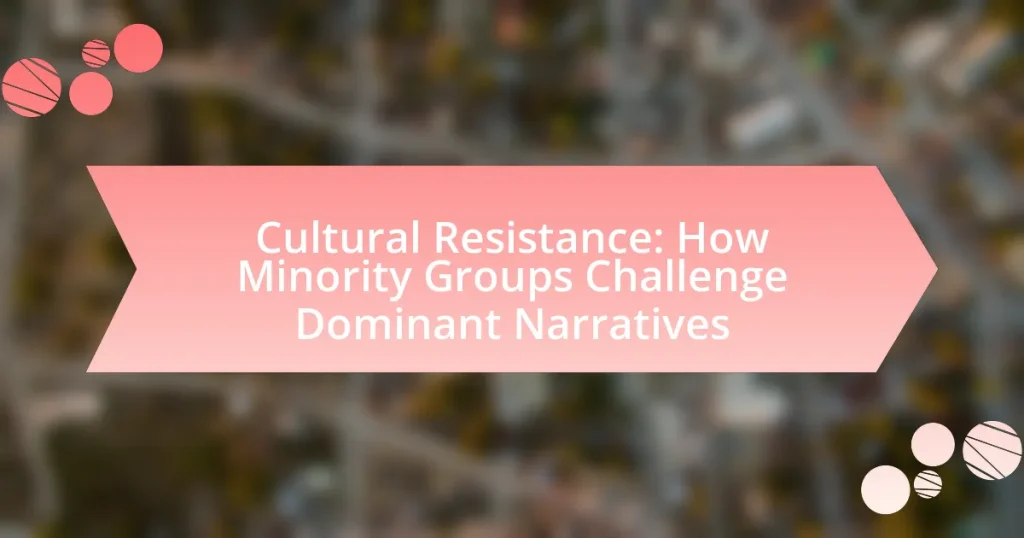Cultural resistance refers to the actions taken by marginalized or minority groups to oppose and challenge dominant cultural narratives and practices. This article explores how cultural resistance manifests through various forms such as art, language, and social movements, emphasizing its role in preserving cultural identity and promoting alternative perspectives. Historical contexts, strategies employed by minority groups, and the psychological impacts of cultural resistance are examined, alongside the challenges faced, including systemic barriers and cultural appropriation. Additionally, the article highlights the importance of education and digital activism in enhancing cultural resistance efforts, ultimately illustrating how these actions contribute to social change and empowerment among minority populations.

What is Cultural Resistance?
Cultural resistance is the act of opposing and challenging dominant cultural narratives and practices, particularly by marginalized or minority groups. This form of resistance manifests through various means, such as art, language, and social practices, aimed at preserving cultural identity and promoting alternative perspectives. Historical examples include the Civil Rights Movement in the United States, where African American communities utilized music, literature, and protests to contest systemic racism and assert their cultural heritage. Such actions demonstrate how cultural resistance serves as a vital tool for social change and empowerment among minority populations.
How do minority groups define cultural resistance?
Minority groups define cultural resistance as the active and conscious effort to preserve, promote, and assert their cultural identity in the face of dominant societal pressures. This definition encompasses various forms of expression, including art, language, and traditions, which serve as tools for asserting their unique cultural narratives. For instance, Indigenous communities often engage in cultural resistance by revitalizing traditional practices and languages that have been suppressed by colonial forces, thereby reclaiming their identity and heritage. This form of resistance is validated by historical examples, such as the civil rights movements, where African American communities utilized music and literature to challenge systemic racism and assert their cultural significance.
What are the historical contexts of cultural resistance?
Cultural resistance historically arises in contexts where marginalized groups confront dominant societal narratives and power structures. For instance, during colonial rule, indigenous populations often engaged in cultural resistance by preserving their languages, traditions, and practices despite oppressive policies aimed at erasure. The civil rights movement in the United States exemplifies another context, where African Americans utilized cultural expressions, such as music and art, to challenge systemic racism and assert their identity. Additionally, the feminist movements of the 20th century showcased cultural resistance through literature and activism that questioned patriarchal norms. These examples illustrate that cultural resistance is deeply rooted in historical struggles against oppression, reflecting the resilience and agency of minority groups in asserting their identities and rights.
How does cultural resistance manifest in different societies?
Cultural resistance manifests in different societies through various forms such as art, language preservation, and social movements. For instance, Indigenous communities often use traditional storytelling and art to assert their identity and challenge colonial narratives, as seen in the works of Native American artists who incorporate cultural symbols into contemporary art. Additionally, language preservation efforts, like the revitalization of the Māori language in New Zealand, serve as a means of resisting cultural assimilation and asserting sovereignty. Social movements, such as the Black Lives Matter movement in the United States, exemplify cultural resistance by challenging systemic racism and advocating for social justice through protests and community organizing. These manifestations highlight how minority groups actively engage in preserving their cultural identity and challenging dominant societal narratives.
Why is cultural resistance important in challenging dominant narratives?
Cultural resistance is important in challenging dominant narratives because it empowers marginalized groups to assert their identities and perspectives. This assertion disrupts the prevailing narratives that often marginalize or misrepresent these groups, fostering a more inclusive discourse. For instance, the Civil Rights Movement in the United States utilized cultural resistance through art, music, and literature to challenge systemic racism and promote social justice, effectively reshaping public perception and policy. Such resistance not only highlights alternative viewpoints but also encourages critical examination of societal norms, ultimately leading to greater equity and understanding.
What role does cultural identity play in resistance?
Cultural identity plays a crucial role in resistance by providing a framework for individuals and groups to assert their values, beliefs, and practices against dominant narratives. This assertion often manifests in the preservation and promotion of unique cultural expressions, which serve as a form of defiance against oppression. For instance, the civil rights movement in the United States utilized African American cultural identity through music, art, and literature to challenge systemic racism and advocate for equality. This cultural mobilization not only fostered solidarity among marginalized communities but also highlighted the importance of cultural heritage in the struggle for social justice.
How does cultural resistance influence social change?
Cultural resistance influences social change by enabling marginalized groups to challenge and reshape dominant narratives. This resistance manifests through various forms of expression, such as art, literature, and activism, which highlight social injustices and promote alternative viewpoints. For instance, the Civil Rights Movement in the United States utilized cultural resistance through music, literature, and public demonstrations to advocate for racial equality, ultimately leading to significant legislative changes like the Civil Rights Act of 1964. Such movements illustrate how cultural resistance not only raises awareness but also mobilizes communities, fostering a collective identity that can drive systemic change.

What strategies do minority groups use in cultural resistance?
Minority groups employ various strategies in cultural resistance, including the preservation of cultural practices, the use of art and storytelling, and the formation of solidarity networks. These strategies enable minority communities to assert their identity and challenge dominant narratives. For instance, the preservation of traditional languages and customs serves as a means of maintaining cultural heritage against assimilation pressures. Additionally, art forms such as music, literature, and visual arts often convey messages of resistance and resilience, exemplified by movements like the Harlem Renaissance, which highlighted African American culture and experiences. Furthermore, solidarity networks, such as community organizations and social movements, provide support and amplify voices, as seen in the rights movement, which has successfully challenged societal norms and advocated for equality. These strategies collectively empower minority groups to resist cultural erasure and assert their presence in society.
How do art and literature serve as tools for cultural resistance?
Art and literature serve as tools for cultural resistance by providing platforms for marginalized voices to express dissent against dominant narratives. Through various forms of expression, such as poetry, novels, and visual art, creators can challenge societal norms and highlight injustices faced by their communities. For instance, the Harlem Renaissance utilized literature and art to assert African American identity and critique racial oppression, effectively reshaping cultural discourse. Additionally, works like “The Handmaid’s Tale” by Margaret Atwood critique patriarchal structures, illustrating how literature can provoke thought and inspire activism. These examples demonstrate that art and literature not only reflect cultural struggles but also mobilize communities towards resistance and change.
What are some notable examples of artistic expression in resistance?
Notable examples of artistic expression in resistance include the works of the Harlem Renaissance, which showcased African American culture and challenged racial stereotypes through literature, music, and visual arts. Artists like Langston Hughes and Zora Neale Hurston used poetry and prose to articulate the struggles and aspirations of Black Americans, fostering a sense of identity and community. Additionally, the mural movement in Mexico, led by artists such as Diego Rivera and David Alfaro Siqueiros, served as a political tool to address social injustices and promote revolutionary ideals. These artistic expressions not only reflected the socio-political climate of their times but also inspired collective action and awareness among marginalized groups.
How does storytelling contribute to cultural resistance?
Storytelling contributes to cultural resistance by preserving and transmitting the values, beliefs, and experiences of marginalized groups, thereby challenging dominant narratives. Through oral traditions, literature, and other forms of storytelling, minority communities articulate their identities and histories, often countering mainstream representations that may misrepresent or erase their experiences. For instance, Indigenous storytelling practices have been crucial in maintaining cultural heritage and asserting land rights, as seen in the works of authors like Leslie Marmon Silko and Sherman Alexie, who use narrative to highlight the complexities of Native American life. This form of resistance not only fosters community solidarity but also educates broader audiences, promoting understanding and empathy towards minority perspectives.
What role does community organization play in cultural resistance?
Community organization plays a crucial role in cultural resistance by uniting individuals around shared identities and values to challenge dominant narratives. This collective action fosters solidarity, enabling marginalized groups to articulate their cultural expressions and resist assimilation pressures. For instance, the Civil Rights Movement in the United States exemplified how community organizations mobilized grassroots efforts to confront systemic racism, leading to significant legislative changes like the Civil Rights Act of 1964. Such historical examples illustrate that organized community efforts are essential for amplifying minority voices and preserving cultural heritage against dominant societal forces.
How do grassroots movements foster cultural resistance?
Grassroots movements foster cultural resistance by empowering marginalized communities to reclaim their narratives and challenge dominant cultural norms. These movements often utilize local knowledge, traditions, and practices to assert their identity and values against mainstream influences. For instance, the Civil Rights Movement in the United States mobilized grassroots organizations to promote African American culture and rights, leading to significant societal changes and the establishment of new cultural expressions that resisted oppressive narratives. This empowerment is evidenced by the creation of community art, music, and literature that reflect the experiences and struggles of these groups, thereby reinforcing their cultural identity and resilience.
What are the impacts of collective action on dominant narratives?
Collective action significantly alters dominant narratives by amplifying marginalized voices and challenging prevailing societal norms. When groups unite for a common cause, they create a platform that disrupts traditional power dynamics, often leading to a reevaluation of accepted truths. Historical examples include the Civil Rights Movement, where collective protests and advocacy led to the recognition of systemic racism and the eventual implementation of legislative changes, such as the Civil Rights Act of 1964. This demonstrates that organized efforts can reshape public discourse and influence policy, thereby transforming dominant narratives into more inclusive and representative frameworks.

What challenges do minority groups face in cultural resistance?
Minority groups face significant challenges in cultural resistance, primarily due to systemic oppression and marginalization. These challenges include limited access to resources, which hampers their ability to promote and sustain their cultural practices. For instance, economic disparities often restrict minority communities from funding cultural initiatives or events that could foster cultural identity. Additionally, social stigma and discrimination can lead to a lack of support from broader society, making it difficult for minority groups to assert their cultural narratives. Research indicates that minority groups often encounter barriers such as language differences and cultural misunderstandings, which further complicate their efforts to resist dominant narratives. These factors collectively hinder the effectiveness of cultural resistance movements, as they struggle to gain visibility and recognition in a landscape dominated by majority perspectives.
How do systemic barriers affect cultural resistance efforts?
Systemic barriers significantly hinder cultural resistance efforts by perpetuating inequalities that minority groups face. These barriers, such as discriminatory policies, lack of access to resources, and social stigmas, limit the ability of these groups to effectively mobilize and advocate for their cultural narratives. For instance, research by the American Psychological Association highlights that systemic racism can lead to decreased mental health and community cohesion, which are critical for organizing resistance movements. Consequently, the presence of systemic barriers not only stifles the voices of minority groups but also undermines their capacity to challenge dominant narratives effectively.
What are the consequences of cultural appropriation on resistance?
Cultural appropriation undermines resistance by diluting the authenticity of marginalized cultures and reinforcing power imbalances. When dominant groups adopt elements of minority cultures without understanding their significance, it can lead to the commodification of cultural symbols, which diminishes their original meaning and context. This appropriation often results in the erasure of the struggles and histories associated with those cultural elements, making it harder for minority groups to assert their identities and resist oppression. For instance, the commercialization of Indigenous motifs in fashion can trivialize the cultural heritage and political struggles of Indigenous peoples, thereby weakening their resistance efforts against systemic injustices.
How do legal and political frameworks hinder or support cultural resistance?
Legal and political frameworks can both hinder and support cultural resistance, depending on their design and implementation. Supportive frameworks, such as anti-discrimination laws and policies promoting cultural diversity, empower minority groups to express their identities and challenge dominant narratives. For example, the United Nations Declaration on the Rights of Indigenous Peoples provides a legal basis for indigenous communities to assert their cultural rights and resist assimilation. Conversely, restrictive laws, such as censorship or policies that marginalize certain groups, can suppress cultural expression and inhibit resistance. Historical instances, such as the suppression of civil rights movements in the United States through legal means, illustrate how political frameworks can obstruct cultural resistance efforts. Thus, the impact of legal and political frameworks on cultural resistance is contingent upon their alignment with principles of equity and inclusion.
What are the psychological impacts of cultural resistance on minority groups?
Cultural resistance can lead to significant psychological impacts on minority groups, including increased resilience and identity affirmation. When minority groups actively resist dominant cultural narratives, they often experience a strengthened sense of community and belonging, which can enhance their self-esteem and overall mental well-being. Research indicates that collective resistance fosters solidarity, reducing feelings of isolation and marginalization. For instance, a study published in the Journal of Social Issues found that engagement in cultural resistance activities positively correlated with psychological empowerment among marginalized communities. This empowerment can mitigate the effects of discrimination and promote mental health, illustrating that cultural resistance serves as a crucial mechanism for psychological resilience in minority groups.
How does cultural resistance affect group identity and cohesion?
Cultural resistance strengthens group identity and cohesion by fostering a shared sense of purpose and belonging among members of minority groups. This phenomenon occurs as individuals collectively oppose dominant narratives, which reinforces their unique cultural values and practices. For instance, the Civil Rights Movement in the United States exemplified how African American communities united against systemic racism, thereby solidifying their cultural identity and enhancing group solidarity. Research indicates that cultural resistance can lead to increased social cohesion, as members engage in collective actions that affirm their identity, such as protests, cultural festivals, and community organizing. These activities not only challenge the status quo but also create a supportive environment that nurtures group identity, ultimately leading to stronger cohesion within the community.
What mental health challenges arise from cultural resistance efforts?
Cultural resistance efforts can lead to significant mental health challenges, including increased stress, anxiety, and feelings of isolation. These challenges arise as individuals from minority groups confront societal pressures and discrimination while advocating for their cultural identities. Research indicates that the psychological toll of navigating these adversities can result in heightened levels of emotional distress, as individuals may experience a lack of support from the dominant culture and face backlash for their resistance efforts. For instance, a study published in the Journal of Counseling Psychology found that individuals engaged in cultural resistance often report higher rates of depression and anxiety due to the constant struggle against systemic oppression and the emotional labor involved in advocating for change.
What practical steps can minority groups take to enhance cultural resistance?
Minority groups can enhance cultural resistance by actively preserving and promoting their cultural heritage through education, community engagement, and the use of digital platforms. Education initiatives, such as cultural workshops and language classes, empower individuals to understand and appreciate their cultural identity, which strengthens community ties. Community engagement, including organizing cultural festivals and events, fosters solidarity and raises awareness about minority issues. Additionally, leveraging digital platforms for storytelling and sharing cultural narratives allows minority groups to reach broader audiences, challenge stereotypes, and assert their cultural presence in the public sphere. These steps are supported by research indicating that cultural preservation efforts can lead to increased social cohesion and resilience among minority populations.
How can education be leveraged to promote cultural resistance?
Education can be leveraged to promote cultural resistance by integrating diverse cultural perspectives into curricula, thereby empowering minority groups to challenge dominant narratives. This approach fosters critical thinking and awareness of cultural histories, enabling students to recognize and question systemic inequalities. For instance, programs that include indigenous history and literature not only validate these cultures but also encourage students to engage in activism and advocacy. Research indicates that culturally relevant pedagogy enhances student engagement and academic success, as seen in the work of Ladson-Billings (1994), which highlights the importance of connecting education to students’ cultural contexts. By equipping learners with knowledge and skills rooted in their cultural identities, education becomes a powerful tool for resistance against cultural erasure and marginalization.
What role does digital activism play in modern cultural resistance?
Digital activism serves as a crucial tool in modern cultural resistance by enabling marginalized groups to amplify their voices and challenge dominant narratives. Through platforms like social media, activists can quickly disseminate information, mobilize support, and raise awareness about social injustices, effectively bypassing traditional media gatekeepers. For instance, movements such as Black Lives Matter have utilized hashtags and viral campaigns to highlight systemic racism and police brutality, leading to widespread public discourse and policy discussions. This demonstrates that digital activism not only fosters community solidarity but also influences cultural perceptions and political action, thereby reshaping societal norms and values.
